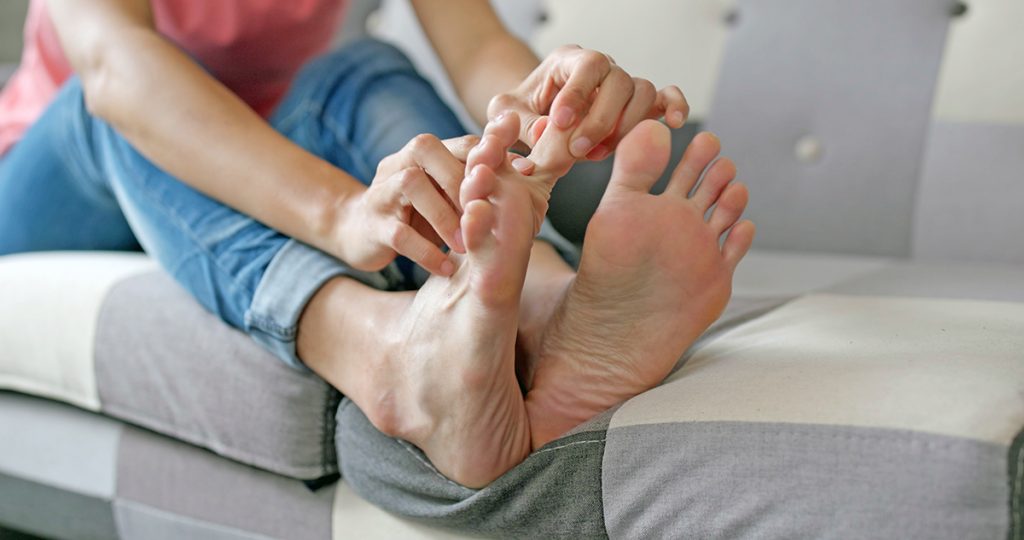Common Foot Problems Associated With Diabetes
Foot problems can happen to anyone. For those with diabetes though, there are certain foot problems in diabetics to watch for. In fact, there are certain conditions more common in diabetics and can lead to major foot problems. These can lead to infection and more complications. In severe cases, amputation may be needed.
Athlete’s Foot
This fungus causes redness, itching, and cracked skin. Germs can get through the cracked skin causing infection though. Medication is needed to treat the athlete’s foot fungus.
Blisters
These develop when your shoe rubs the same area of skin. Shoes that do not fit are the most common cause. Blisters can become infected when they break open. Do not pop blisters! Instead, cover them to prevent infections. Use antibacterial creams and keep the area clean to treat them.
Bunions
This occurs when your big toe bends inward. The joint of your big toe and foot become callused. It can also stick out and get very hard. Bunions can run in families. However, another cause of bunions is narrow fitted shoes. High-heeled shoes also put too much pressure on the toes. Therefore, too much pressure is placed on the big toe. Then, it pushes towards the second toe. With time, this causes a bunion to form. Foam padding in shoes can help prevent irritation. You may also need surgery if it causes severe pain.
Calluses
This is hard built-up skin on the underside of the foot. Uneven distribution of weight and poorly fitting shoes are to blame. Some callus is normal though. However, your doctor can advise if they are becoming a problem. You can use a pumice stone to remove calluses. This is best when the skin is wet. Wear insoles in your shoes. Do not cut into the callus.
Corns
Corns are another build-up of hard skin. This time near or between toes. Pressure from shoes rubbing against your toes can cause these. You can remove these with a pumice stone as well. Do not cut into the corn. Also, do not use over-the-counter medications to dissolve them.
Diabetic Ulcers
An ulcer is a deep sore. These are common among diabetics and are easily infected. Small cuts that heal slowly can develop into ulcers. They need to be treated right away. Your doctor can advise how best to treat your diabetic ulcer.
Dry Skin
Dry skin cracks and allows germs to enter. You must try to prevent this though, to avoid infection. As a matter of fact, to prevent cracking, using a moisturizer works great!
Also, see: Manage Dry Cracked Heels
Fungal Infections
Infected nails will become discolored. They will also be brittle and may crumble. Shoes are dark and moist and this fosters bacterial growth. An injury to the nail can allow an infection to develop. Medication can treat fungal infections. But, these are not always guaranteed. Medications are taken orally. In some cases, however, the nail may be removed.
Hammertoes
This is a toe that has bent as a result of a weakened muscle. Weak muscles cause tendons to shorten. As a result, the toe curls under the foot. They can be accused of wearing short shoes. Hammertoe can also run in families. Hammertoes make it hard to walk and can cause blisters. You can treat them with splints and corrective shoes. You may need surgery in severe cases.
Ingrown Toenails
A toenail is ingrown when its edges grow into the skin. Pressure increases along the edges of the nail. The nail cuts your skin. This causes redness, swelling, and infection. Poorly fitting shoes and untrimmed nails are common causes. Repeated trauma can also cause ingrown nails. Keep your toenails properly trimmed to avoid this. Persistent problems can result in infection. The need for surgery is rare with an ingrown toenail and only done in severe cases.
Plantar Warts
Plantar warts look like calluses. But, they are found on the heel and ball of the foot. They have small black spots at the center. And they can grow alone or in clusters. These are caused by a virus and are painful. Plantar warts can be removed in several ways.
Diabetic foot is unfortunately common with those living with diabetes. Don’t let foot problems in diabetics become an issue. Combat it now. Call us at 888-409-8006.

